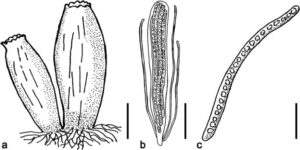Tubeufia Penz. & Sacc., Malpighia 11(11–12): 517 (1898) [1897].
= Linobolus Syd. & P. Syd., Annls mycol. 15(3/4): 204 (1917)
Index Fungorum number: IF 5635; Facesoffungi number: FoF 00063; 57 morphological species (Species Fungorum 2020), 38 species with molecular data.
Saprobic on dead wood. Ascomata without a subiculum, superficial, solitary to gregarious, globose to subglobose, or clavate to obclavate, yellow to orange, becoming dark, occasionally hairy. Peridium composed of pseudoparenchymatous cells. Asci 8-spored, clavate to broadly cylindrical, apex rounded, short pedicellate (Fig. 2b). Ascospores cylindrical to fusiform, elongate, ends rounded, trans-septate, not constricted at septa, hyaline to pale yellow or brown, smooth-walled.
Anamorphs reported for genus – Aquaphila (Goh, K.D. Hyde & W.H. Ho 1998), Helicoma (Corda 1837), Helicosporium (Nees 1816), Monodictys-like, Pendulispora (M.B. Ellis 1961).
Notes – Tubeufia is the type genus of Tubeufiaceae, established by Penzig and Saccardo (1897) based on the type species T. javanica. Boonmee et al. (2014b) designated the epitype of T. javanica with phylogenetic analyses. Lu et al. (2018b) reappraised the taxonomy of Tubeufia and introduced 18 species and six combinations in this genus based on phylogeny and morphology.

Figure 1 – Tubeufia javanica (redrawn from Penzig & Saccardo 1904). a Ascomata. b Ascus with pseudoparaphyses. c Ascospore. Scale bars: a = 100 μm, b, c = 50 μm
Species
